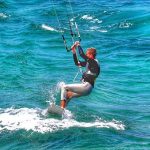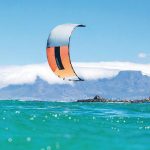Introduction
Kiteboarding is a rapidly growing sport around the world. It didn’t acquire its modern look until the late 1990s. Kiteboarding is also one of the most dangerous extreme sports.
So, the best way to stay safe and enjoy the sport is to choose the right size kiteboarding kite.
What is a kiteboarding kite?
A kite is a kind of kitesurfing sail, similar in some ways to a parachute. A kite is necessary for kitesurfing as it provides the lift needed to fly. There are many different types of kites available, each with different characteristics that make them suitable for different conditions and purposes.
Tube kites are long and narrow with a solid leading edge and a fabric trailing edge. They rely on a “lifting structure” for their shape and are unable to fly without it.
Parafoils are made of a series of interconnected fabric cells that hold their shape when filled with air. There are two primary types of kites: tube kites and parafoils. Tube kites are designed with a solid leading edge and a fabric trailing edge, while parafoils are made of interconnected fabric cells that hold their shape when filled with air.
The two types of kites differ in their abilities and use.
Why choose the exact kiteboarding kite size?
Unfortunately, there is no universal kite size.
The kite size is the most important factor in choosing a kiteboarding kite. It is determined by the length and width of the kite in square meters.
A kiters usually has a set of different sized kites to make the best of the various weather conditions, or they will use rental equipment.
Parameters that you should consider when choosing a kite size include wind and gust speed, rider’s weight and skill level, riding style, and board type. The shape and type of the kite also matter when choosing — a foil kite can be lifted into the air in lighter wind than an inflatable kite.
Each kite also has its wind range:
If the wind force is below the minimum wind range, the kite won’t generate enough power to keep the rider on the board.
If the wind force is above the maximum limit of the wind range, then the thrust will be too high, the athlete will not be able to move forward against the wind, and they will be ‘drained’ by the wind.
You should pick a kite size that is best suited for the wind conditions in the main area where you will be riding most often.
The ideal number of kites to have is either 2 or 3, depending on the wind conditions.
What are the typical and most common kite sizes?
For a general understanding, you can focus on such calculation (but it doesn’t take into account weight and skills):
- Large kite for lighter winds (14–18 m) — 3–7 m/s.
- Medium kite for medium winds (11–13 m) — 7–9 m/s.
- Small kite for higher winds (5–9 m) — 9–13 m/s.
The most common kite size in the world is 12 m². It can be used in a moderate wind, by people of different levels of skill, and is of a medium weight.
How to choose the right kiteboard size for kiteboarding?
It is advisable to slightly reduce the Kite size for lighter kiters and to slightly increase the Kite size with heavier kiters. When choosing a kite size, the two most important factors to consider are the weight of the kiteboarder and the wind speed.
Generally, all kites are designed to be used by someone who weighs 75 kg. If you are lighter than this, it is advisable to choose a slightly smaller kite; if you are heavier, a slightly larger kite.
When choosing what size kite to get, you should go for a smaller kite if you expect the wind to be strong.
The wind speed at which it is safe to ride ranges from 3 to 5 m/s to 15 to 20 m/s. The wind speed that is comfortable for most riders is from about 6 to 12 m/s. Most kite manufacturers produce kite models that range in size from 5 m² to 17 m² (inflatable), or up to 21 m² (parafoils).
If you are new to kite riding, it is advisable to start with a small kite that is at the lower end of the weight and wind range that is right for you.
Those who are not professional riders should aim for a kite that is appropriate for the wind range they are targeting, while professional riders can go for a larger kite to up their speed.
The standard wind range that a kite manufacturer indicates on the packaging is usually only recommended for riders that weigh about 75 kg.
If you weigh more or less than that, you can use the following calculation to determine the size of the kite or wind speed that you should use: for every 10 kg of difference, add or subtract 1 m² for the size of the kite or 1 m/s for the wind speed.
This formula can help you choose the appropriate kite size for different wind speeds and weights.
If, for example, you have a 9 m kite and a wind speed of 10-12 m/s, you would need to use the kite at a lower wind speed of 8-10 m/s. Or, if you want to maintain a speed of 10-12 m/s, you would need to use a smaller kite, such as a 7 m kite.
Some extra and important advice
Do not pick a kite that is too large for you to handle in a weak wind. A kite that is too big can easily pick you up and deposit you harshly onto the ground or water, causing serious injuries.
When choosing a kite you also need to decide on the place you will be flying it and what season it will be. The wind conditions will depend on the direction and speed of the wind as well as the gusts.
The size and type of kite someone chooses is also determined by their skill level. Beginner kites have a smaller range than kites for more experienced riders.
The gender and age of the rider are not important when choosing a kite. Men and women can use the same kite, depending on their weight and skills.
What is a kiteboard size chart?
The kite size wind chart is a tool that can help you choose the right kite and board. It takes into account factors such as the rider’s weight, the wind conditions, and the rider’s skill level.
Choose the size of your kite and board depending on the average wind speed and your weight.
How much wind do kitesurfers need?
The flight of the kite in kitesurfing is determined by three factors: wind speed, the size of the kite, and your weight.
The latter two are more easily manageable (obviously), but there has always been a question of what the “minimum required wind speed” is. So what’s the magic number?
A kitesurfer needs a minimum of 10knots (12mph) of wind speed, while a heavier rider (about 200lbs) will need at least 13 knots (15mph). Although a kite can start flying at 5-7 knots (about 8mph), kitesurfing cannot be performed unless there is enough wind.
How much wind do you need for a 9m kite?
The most common questions I get are about the windspeed you need for 9-meter and 12-meter kites. These kites are part of the “beginner hype” category.
An average kitesurfer needs between 15 and 20 knots of wind speed to kiteboard with a 9-meter height. In comparison, heavy surfers (over 200lbs) will need between 25 and 30 knots of wind speed for a kite this big.
How much wind do you need for a 12m kite?
Kitesurfers who are skilled and lightweight can use a 12 m kite with a wind speed as low as 20 knots (17.3mph). However, others would need a wind speed of at least 21.7 knots (26 mph) to use such a large kite. Heavyweight surfers need to be highly skilled to use bigger kites and would need a wind speed of at least 30 knots (26 mph).
That means that you can use these kites if the wind speed is good. However, you cannot use them all the time because the wind speed changes.
How much wind is too much wind for kitesurfing?
A non-expert cannot ride at 10-15 knots with a 12m kite. A beginner cannot even ride at 25-30 knots. Everything at 30 knots will be twice as fast as at 15 knots and will require much more precision.
This explains why 9m and 12m kites are discouraged for beginners and even enthusiasts. The speed for “too much” wind varies from person to person.
Heavyweights (85 kg+) can kiteboard any size kite in any conditions with the right board. Now, by this logic, people who weigh a lot won’t be able to kiteboard with 9m and 12m kites at all because the wind speed would be too high. But that’s not always the case.
People who weigh a lot (85 kg+) can kiteboard any size kite in any conditions if they have the right board.
It would be difficult for them to improve their precision, however their weight would always give them an advantage in controlling a kite.
Wind Direction
The direction of the wind will have a greater effect on your experience and, more importantly, your safety than the wind speed will.
To kitesurf successfully, you should focus on riding sideshore and side on-shore winds. While side on-shore winds can be difficult to locate, they blow at a 45-degree angle towards the shore, making them ideal for kitesurfing.
You should avoid riding in direct onshore winds, as they will push you towards the shore, which can be dangerous. Only experienced riders who can easily ride upwind should attempt to ride in direct onshore winds, as a small mistake can result in your board getting stuck in the sand and you falling face-first at high speed.
The offshore winds will make it difficult to return back to land. What are you going to do? Swim back? You’ll need some luck for that.
Winds that come from the side and blow toward the shore are considered the best for new riders. This is because they have a straight path to the shore, but it is not too direct. It is easier to launch and come back when riding side-shore winds.
If your kite falls, you will be able to get back to the shore quickly.
If you have already kiteboarded a few times and are ready to enjoy the activity, then sideshore winds are perfect for you.
These types of winds run parallel to the shore, so you won’t have to deal with huge waves. Also, it will be easier to shift between inbound (close to shore) and outbound surfing.
Quality of Wind
The quality of wind is not entirely objective as different people can have different definitions of what stable wind is. Instead of getting too technical and explaining what I personally like, I’ll give you some general things to keep in mind.
Strong and gusty winds are not suitable for beginners.
The wind speed required to travel 10 knots will be lower in the spring, fall, and winter seasons due to colder weather conditions. As the wind gets colder, its density increases, so less speed is required.
Quality of Waves
If you’re just starting out, it’s best to stick to flat water or waves that are no more than 2 feet high. Once you’ve gotten more experience, you can try exploring waves that are 3 feet or taller.
What are the best kitesurfing conditions?
The best kiteboarding/kitesurfing conditions for beginners are when the wind is blowing steadily from the side at 10-15 knots. Advanced surfers and experts tend to go for winds of 15-25 knots because they can control the kite better.
Other Important Factors for Kitesurfing
You will need to consider not only the speed of the wind, but also its direction and how strong it is.
Example of using the chart for 75 kg rider:
- 12 m kite wind range is 7-12 m/s.
- 10 m kite wind range is 9-14 m/s.
- 9 m kite wind range is 9-14 m/s.
- 7 m kite wind range is 10-16 m/s.
What kite size should I get if I weigh 85 kg? For example, if the wind range is 7-12 m/s, you should get a 12-13 kite, and if the wind range is 14-20 m, you should get a 6-7 kite. Simple.
What conditions to avoid while kiteboarding?
The conditions to avoid while kiteboarding are turbulence, wrong wind direction, and bad weather. Any misstep could lead to various accidents.
I won’t discuss wind direction again since you already know about it.
If the wind speed is either high or low and you can’t control your kite, it’s time to call it quits. Don’t try to kiteboard when the conditions are like this because it’s not worth the effort or risk.
If the wind speeds fluctuates between 12 knots and 8 knots, that is not a good sign.
A thunderstorm is another obvious circumstance to avoid. Even if it’s nearby, it’s the worst-case scenario. Lightning travels at over 40mph, and your kite will be the first thing in its way.
If the water temperature is under 60 degrees, you will start to experience hypothermia within 15-20 minutes, which will make it difficult to kite consecutivelaunch.
Lastly, avoid kiteboarding on beaches with a lot of people. Kiteboarding getting banned on a beach is more common than you would think because newbie surfers have been known to hurt people with their kites, hooks, and the kite line.



